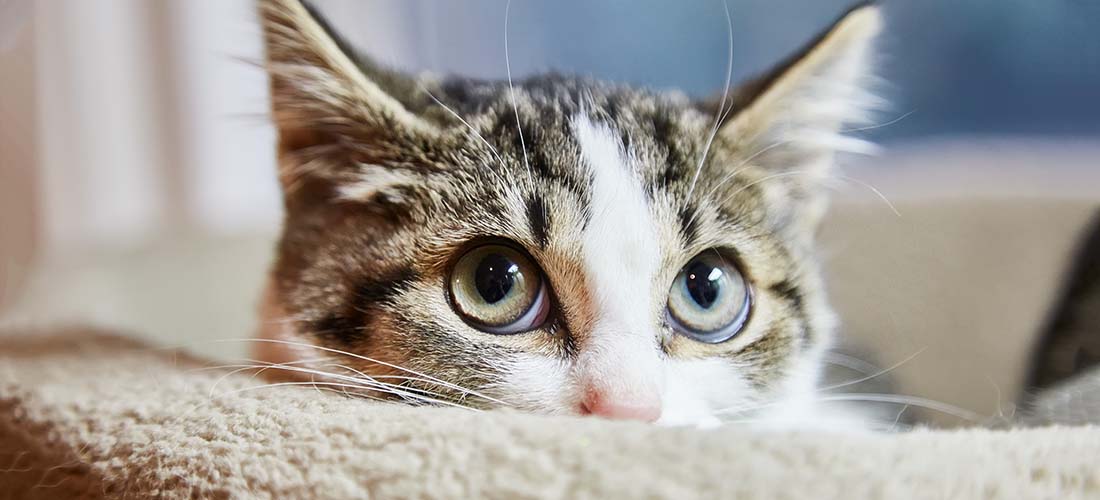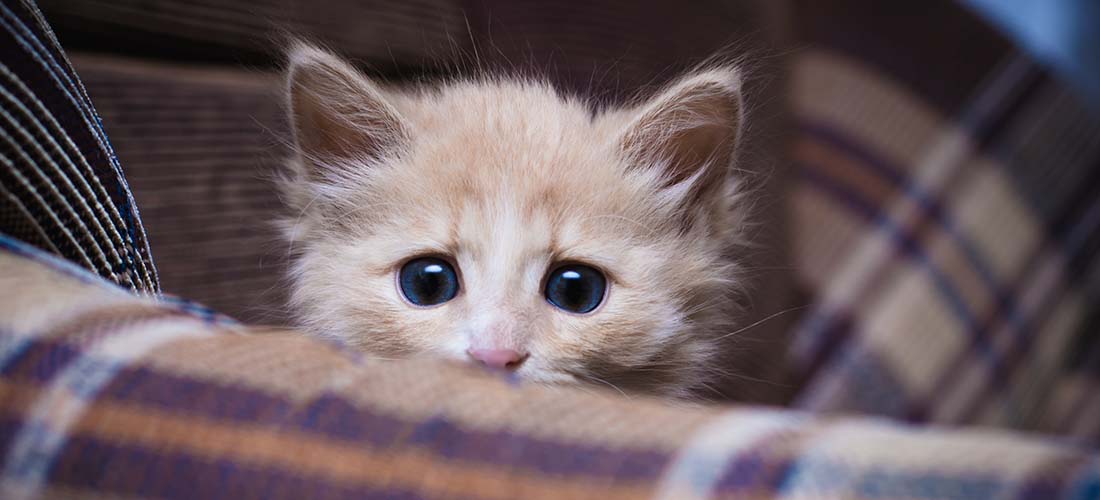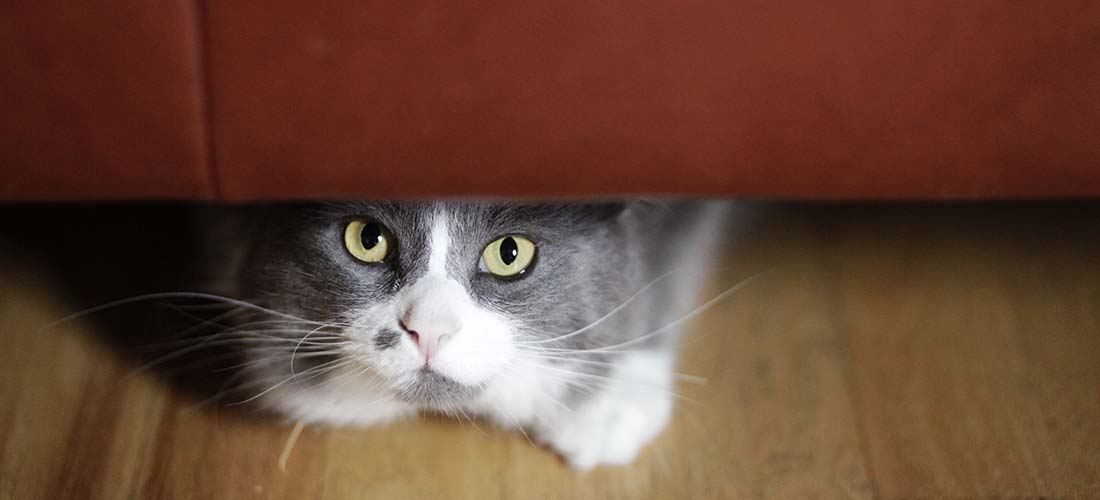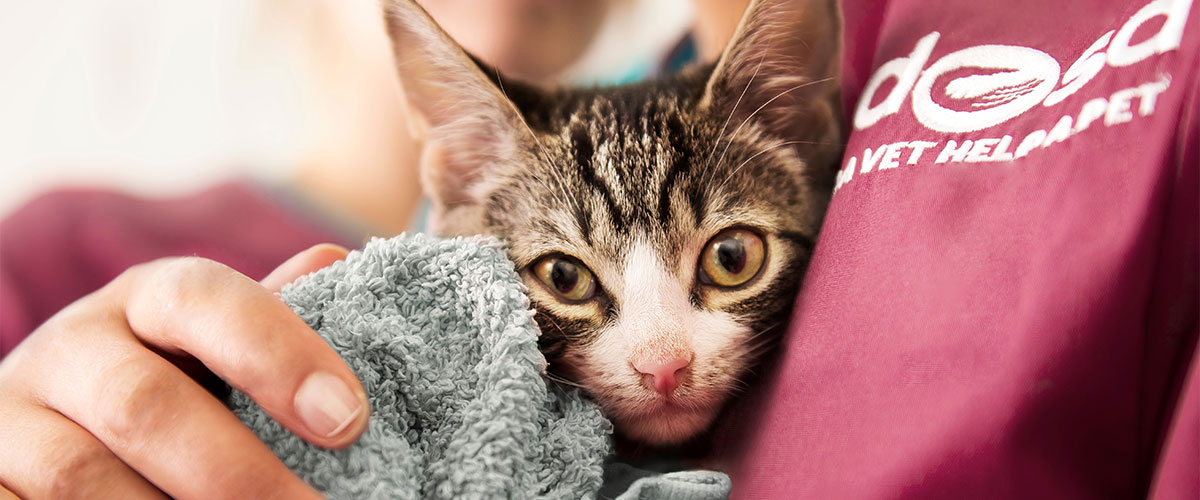Cat fear: how to help a nervous cat
From the loud bangs and the bright lights of fireworks, to storms and lots of festive visitors – the world can be a scary place if you’re a cat! Thankfully, there are lots of ways you can help your furry friend through their anxieties and fears.
We’ve all heard of the term ‘scared-y cat’, but sadly when a cat is scared it’s more than just a phrase. Cats can be afraid of lots of different things and for many owners finding the cause of the problem and knowing what to do next can be a challenge. Unfortunately if your cat is left without any help their fear can lead to stress, anxiety and even illness, especially as fears tend to get worse over time.
Our vets have put together some tips to help you know if your cat might have a fear or phobia as well as advice on how to help them. It’s always important to get your cat checked by your vet if they’re suddenly acting differently. Although most fears are a behavioural issue, your vet will be able to look for any medical problems that could be causing your cat to feel anxious and if needed they can refer your cat to an accredited behaviourist who will be able to help them.
How do I know if my cat is nervous or afraid?

Sometimes it’s clear when your cat is upset about something, but some cats can hide their fear and you may not realise they’re uncomfortable. You might not to see their first reaction when something scares them, especially if it happens while they’re outside, so you may only see the end result which is often hiding or stress.
Signs of fear in cats include:
- Freezing in place or making themselves small by crouching low to the ground and lowering their head
- Running away
- Hiding
- Arching their back and puffing up their fur
- Wide eyes with big pupils that look like ovals or circles
- Tucking their tail under them or swishing the tip quickly side to side
- Moving their ears quickly (as they try to listen) or flattening their ears close to their head
- Hissing or spitting
- Scratching or biting
- Peeing or pooing outside their litter tray.
If you’re seeing any of these signs, it could be your cat is afraid, anxious or stressed and it’s important to get take the steps below to help.
If you have an anxious or fearful cat, they can develop a condition called stress cystitis which causes pain, blood in the urine and can even lead to a blocked bladder. Contact your vet for help as soon as possible if you see signs of these or any other symptoms that are worrying you.
How do I find out what is frightening my cat?
Finding out what’s frightening your cat can be an important step to getting them help. Unfortunately your cat could be scared of almost anything, even things that don’t seem at all frightening to us!
So how can you tell what your cat is afraid of? The first step is to look for the signs listed above. Once you know how to tell when your cat is scared, you can start to match up what is happening at the times they’re afraid.
For some fears, the cause will be clear. For others it can be hard to know exactly why your cat is afraid. But knowing the source of the fear can be really useful to help your cat get better.
Some common examples of cat fears include:
- Strangers or unfamiliar people
- Fireworks
- Other cats
- Loud noises
- Dogs or other predators.
With cats that spend time outdoors, you might struggle to find out exactly what they’re afraid of as you might just see the end result when they come home. Fortunately, there are still lots of ways you can help them.
What can I do to help when my cat is scared or anxious?

If you have a nervous or anxious cat, it’s important to take steps at home to try to reduce their stress and anxiety.
- Make sure they have their own space. One of the most important things for many cats is having a space of their own where they can hide when they’re scared. Why not make them a den if they like to hide under or behind furniture? Or think about making a cosy bed for them on top of a wardrobe, or putting up shelves for them to sit on if they prefer to be up high?
- Avoid or reduce the things that scare them. If it’s possible to avoid or reduce the cause of their fear this will often help to stop their fear getting worse. If your cat is scared of something they come across while they’re outside, it might be best to keep them indoors for part of the day. They might even be happier staying at home all the time, especially if this means you can keep them away from whatever is scaring them. If they seem to be more stressed when they’re stuck inside, make sure they have an easy way to get in and out as they choose, for example using a microchip cat flap.
- Give them space. Some cats will want to come to you for comfort when they are afraid, while others will want to hide or be left alone. It’s always best to respect your cat’s choice and don’t force them to come to you if they’re scared - this could actually make them feel more afraid.
- Close the curtains and try playing music or the TV. Cats have very sensitive hearing and can find it stressful when strange things are happening outside (like storms and fireworks). If you notice your cat seems anxious, try shutting the curtains and putting on some music or the TV so they can relax somewhere safe and cosy, especially if your cat is scared of things you can’t control or loud noises like fireworks.
- Always stay calm. Cats will often pick up if you’re afraid or stressed, so trying to stay calm is really important. If they are showing signs of stress your staying calm will help them feel more at ease.
- Try to stick to a routine. Most cats love routine as it means they can predict what’s going to happen next. Feed and let your cat out at the same time each day. You could also put aside some special time each day when you fuss or play with your cat if they enjoy it so they know when they’ll have your undivided attention!
- Introduce new things slowly. Sometimes change can frighten your cat, especially if they aren’t prepared and they find something new in their home which they feel they can’t get away from. If you’re making any changes to your house, try to make it a gradual change if possible. Always make sure your cat has somewhere they can go if they want to be away from the new things. Cats also like an opportunity to look at things, sniff them or explore them so if possible try to give them some supervised access at the start so they can get used to any new sights, sounds or smells in a safe way. If you’re expecting a new addition to your household, we have guides on introducing cats and dogs and preparing your pet when you’re having a baby.
- Keep a few litter trays inside. If your cat feels scared of something outside they might not want to toilet outdoors, so make sure you have at least two litter trays in different places in the house for them to use if they need to.
- Try a pheromone plug-in. These products can help your cat feel calm and ease any tensions in the house. Take a look at some of our vet-recommended diffusers.
- Make sure they’re microchipped and your details are up to date. If your cat is frightened they could panic, run away and get lost. If they’re microchipped and your details are up to date, you have a much better chance of being reunited if they can’t find a way to get home. Vets and rescue centres will scan your cat’s microchip and be able to contact you if your cat is brought to them.
- Contact your vet and an accredited behaviourist. We’d recommend contacting your vet as soon as possible if your cat might be afraid or anxious as fears tend to get worse over time. Not only is this distressing for your cat but their behaviour will often become more and more extreme. We also recommend contacting a behaviourist accredited with the ABTC.
What is de-sensitisation and does it work for cats?

If your cat has severe fears or phobias, they may need a 'behaviour modification plan' which helps to change their behaviour and make them less afraid. One of the most well-known techniques is de-sensitisation. This is a process of gradually exposing your cat to something in a slow, positive and controlled way. Most people think about it being used for dogs but it can help cats, too. Contact your vet and an accredited behaviourist to find out more.
For some fears or phobias, for example the vacuum cleaner, you can buy a special de-sensitisation CD which will have common sounds on. You can introduce these to your cat over time so they learn not to be scared. You need to start the process by putting the CD on a very low volume and giving your cat lots of praise and rewards (this could be a tasty snack or a fun game). When your cat becomes comfortable with the noises, you can turn the volume up slightly. Always make sure they are happy and relaxed with the current volume before turning it up. If they start to show signs of anxiety or stress, stop and restart the process at the lowest volume. Cats may take a while to get used to new noises so be patient and make sure you start the process as early as possible.
Remember, there are some things your cat should want to run away from so be careful about desensitising your cats to noises like car engines as this could make them a little too confident around traffic.
Does my cat need medication to help with their problem?
Some cats will need medication to help with their anxiety alongside behavioural treatment plans. There are a number of different medications that are licensed or recommended for cats.
Never use human anti-anxiety medications on your cat. They can have side effects (including sometimes making your cat’s anxiety worse) and some could be dangerous to your pet. Speak to your vet if you think your cat may need medications to help with their fear.
How to build a den for your cat
Dens can help give your cat somewhere they can hide in order to feel safe if they’re afraid. Check out our video for tips on making the perfect cat den:
 Video found at youtu.be/K263-610wiw
Video found at youtu.be/K263-610wiw
Socialisation for kittens
The best way to prevent fears and phobias is through socialisation.
When your kitten is young they find it much easier to learn how to respond confidently to different situations which helps them become happy adults. It’s important to introduce your kitten to lots of different experiences in a positive way, including things like loud noises and new people. This will help them learn how to respond when they come across them in future. This process is called socialisation.
Early socialisation starts at your kitten’s breeder or rescue centre and continues with you once you bring them home. If your kitten doesn’t have lots of differed positive experiences when they’re young (or they have a bad experience during socialisation), this could lead to fears and phobias in later life.
You can find out more about socialising your kitten in our guide.
Stress-free
Our vets give their advice on keeping your feline friend stress-free and as relaxed as possible at home.
Time to chillFireworks
Read our free advice on preparing your cat for fireworks season and keeping them calm and happy.
Be preparedYour home
Where we live is important – and it’s no different for our cats! Find out about how to give them the perfect home.
Our free guide
